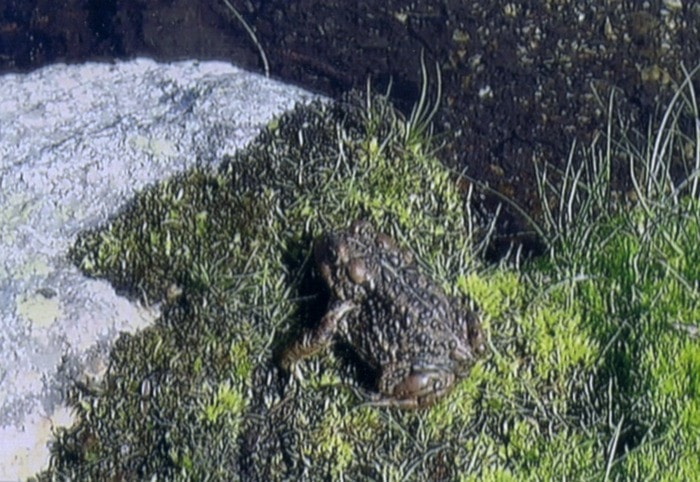Creatures that I encounter quite frequently on my trips into Haystack Mountain are large toads. There, I also often encounter lots of mosquitoes, especially on warm, cloudy days. Perhaps this is the reason for all the toad sightings. In fact, I may meet up with two at different points along the trail up to the lakes. Sometimes they catch me by surprise, for what at first seems to be a rock on the trail suddenly becomes a live toad, hopping off the trail as I approach.
These wary creatures have good eyesight as well as sensitive hearing, and are also quite sensitive to ground vibrations; thus, they can keep close tabs on happenings in their surroundings. Like many forms of animal life they are more aware of me than I am of them.
The trail makes a good place for these day-active toads to hang out as insects use the trail for a flyway and a place to warm up even on a cloudy day. It is also a good place for toads to warm up in the morning and snap up insects on the wing or on the bare trail.
My Haystack toads have seemed to always have a handy place of refuge. Their place of safety is quite obvious when there is an alpine stream or pool nearby or dense ground cover, like along the trail. To seek cover, they just hop off the trail into the concealing vegetation. But this one toad foxed me. It hopped to the edge of the trail to disappear out of sight under a slight overhang. “Ah, ha,” I thought. “I will just peak under the little overhang and get a glimpse of this evasive personality.” Sure enough, there it sat, but surprise; it sat right in the entrance to a little burrow where, under my prying eye, it immediately disappeared into the darkness. I stuck my hand in to locate it, but felt just more tunnel. Well, another place of refuge.
In favour of alpine toads, snow comes early at high elevations, protecting the ground and its inhabitants from winter’s frost, chilly blasts and dehydrating winds. The burrow toad likely uses the same ground squirrel tunnel winter after winter for hibernation. Or, each winter, it might co-habit with the owner. Neither a ground squirrel nor marmot would bother a toad, as those bumps under the skin on the back, if broken, would spill out a smelly, as well as poisonous, substance. Tiger salamanders are also known to occupy and hibernate in burrows coming out each day, or in the spring, unscathed from their underground existence.
If you visit Haystack Mountain’s alpine meadows you may also find these large, often three-inch, toads on the open matted vegetation around pools and little streams and seeps waiting for food to pass by or, perhaps, waiting to see if they need to flee, out of your reach, to a place of refuge. For these creatures, burrows under large boulders, deep rock crevices and overhangs of thick moss along streamlets, make good places to spend the winter. Their body temperature will go with the surrounding temperature and even drop below freezing, while at the same time looking very lifeless. They do not freeze. They, like other amphibians and reptiles go underground for the inclement season, but other than that don’t make many external preparations for the winter. They just sleep away under that protective ten-foot blanket of snow.
Now, you can’t go into hibernation for the winter like I have heard some of you say. You are not equipped for that. I guess you already know that, to stay healthy, you must be active all year round, as well as all winter. The results of hibernating would be devastating. In case you didn’t think about it, physical activity and exercise get oxygen into the blood, increasing the blood flow, carrying oxygen to each individual body cell, a very necessary phenomenon. Oxygen deficient cells are weak cells. Weak cells are vulnerable to disease! So avoid “hibernation”, not only to stay alive but to stay healthy, or get on the road to health (a hard saying when a festive season is at the door).
Ed McMackin is a biologist by profession but a naturalist and hiker by nature. He can be reached at 250-866-5747.
